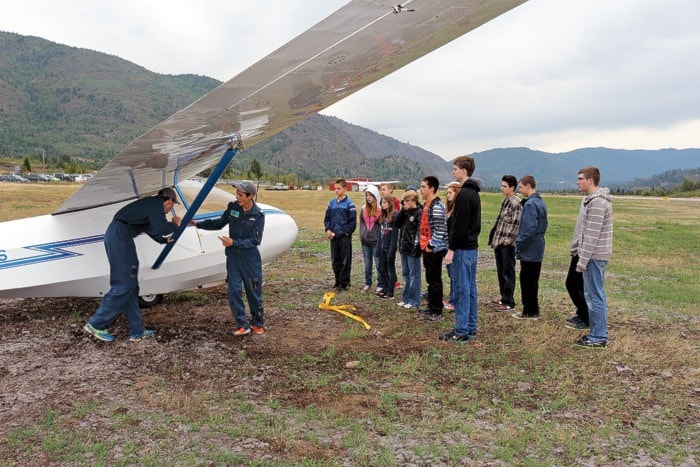On Saturday, Sept. 21 about a dozen air cadets turned out at the Trail Airport to take to the sky in two gliders as part of their aviation training.
It was an overcast and somewhat drizzly morning but the excitement was palpable as the boys and girls spent some time learning about the two long-winged gliders being inspected and prepared on the runway.
"When a cadet reaches the age of 16, they can apply for a glider pilot scholarship," said Lt./CO Jim Hossack of the 531 Trail Air Cadets. "To apply for this they must take a ground school course to study for the entrance exam, which we offer for free at the Selkirk Aviation College in Castlegar. Then they must pass a province-wide qualifying examination in early January, go through a review board, and then have Transport Canada medical certification. If they are selected, they go through a six-week training course to get their Glider Pilots license."
The squadron graciously offered flights to this reporter in both the glider (a Schweizer SGS 2-33) and the tow plane (a Cessna 182), something eagerly accepted.
The gliders, built in the 1970s, each weigh a little over 270 kilograms and passengers can't be insulted when they ask how much they tip the scales at… such things are important when flying without the benefit of engines or natural wings.
First though, cadets Shael Huska and Brayden Koprowsky walked everyone through an orientation, carefully explaining how and precisely where to hold the relatively fragile gliders while moving them on and off the runway. The group listened intently while the two explained how to "call the wing" and what signals to watch for before the tow plane carries it aloft.
Once the safety briefing and instructions were concluded, the cadets organized into small work teams to help launch each flight with a qualified pilot and cadet aboard. Three of the cadets had not flown in the gliders before; one such person was Jayden Bowcock who recounted what it was like to get up in the air.
"We turned the glider around and we practiced holding it steady and keeping the wings even," said Bowcock. "Then I learned how to go down and up and make turns."He said he couldn't quite remember every detail of what some maneuvers were called because the experience, although "really awesome," was also somewhat short.
My pilot in the glider, Fraser Neave, said the cool, damp air made the gliders sink much faster than they would in the dry heat of summer and the duration of each flight was around 10 to 15 minutes. Neave received his license in 2007 when he was just 16-years-old and effortlessly recounted a number of facts and details about the aircraft while guiding the craft through a tear-dropped flight path that started at about 2,500 feet.
Free from noisy engines, the aircraft is remarkably quiet and reached about 90 km/hr as it slowly circled it's way to the airport. Though cramped inside, with some dual-seat controls smacking my legs, the small cabin provided a great view of the surrounding landscape.
The Royal Canadian Air Cadets is a national co-educational youth organization sponsored by the Canadian Forces in partnership with the civilian Air Cadet League of Canada. In B.C. there are approximately 3,700 air cadets enrolled in 57 squadrons. The B.C. Ministry of Education, Skills and Training recognizes the cadet program as a “ministry-accepted external course” for which students may receive graduation credit.
